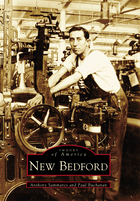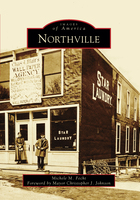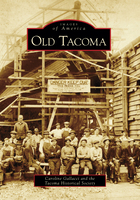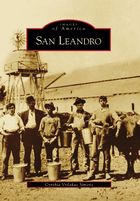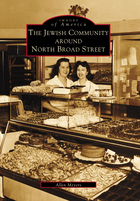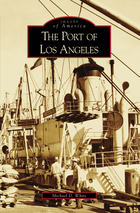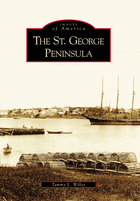Browse Titles - 76 results
7. Whaling
written by Anthony Mitchell Sammarco and Paul Buchanan, 1956-; in New Bedford, Images of America (Charleston, SC: Arcadia Publishing, 2003), 81-98
In 1765, when Joseph Rotch sailed across the bay from Nantucket, he brought with him the skills and knowledge to start New Bedford's whaling industry. By 1830 the town was a larger whaling port than Nantucket, with an immense fleet employing more than 10,000 people.
Sample
written by Anthony Mitchell Sammarco and Paul Buchanan, 1956-; in New Bedford, Images of America (Charleston, SC: Arcadia Publishing, 2003), 81-98
Description
In 1765, when Joseph Rotch sailed across the bay from Nantucket, he brought with him the skills and knowledge to start New Bedford's whaling industry. By 1830 the town was a larger whaling port than Nantucket, with an immense fleet employing more than 10,000 people.
Field of Study
American History
Content Type
Book
Author / Creator
Anthony Mitchell Sammarco, Paul Buchanan, 1956-
Date Published / Released
2003
Publisher
Arcadia Publishing
Series
Images of America
Topic / Theme
Whaling
Copyright Message
Copyright © 1997 by Anthony Sammarco and Paul Buchanan
×
2. Gristmill Spurs Growth
written by Michele M. Fecht; in Northville, Images of America (Charleston, SC: Arcadia Publishing), 21-32
Most of the first pioneers came from New York by steamship across Lake Erie, disembarking in Detroit in the 1820s. From Detroit, it would take three days of treacherous travel through dense forests, thick brush, and swampy countryside to reach their destination—a hilly region in the northwest corner of Plymouth...
Sample
written by Michele M. Fecht; in Northville, Images of America (Charleston, SC: Arcadia Publishing), 21-32
Description
Most of the first pioneers came from New York by steamship across Lake Erie, disembarking in Detroit in the 1820s. From Detroit, it would take three days of treacherous travel through dense forests, thick brush, and swampy countryside to reach their destination—a hilly region in the northwest corner of Plymouth Township that would come to be called Northville. In the nearly 200 years since the first pioneers cleared the land and established the...
Most of the first pioneers came from New York by steamship across Lake Erie, disembarking in Detroit in the 1820s. From Detroit, it would take three days of treacherous travel through dense forests, thick brush, and swampy countryside to reach their destination—a hilly region in the northwest corner of Plymouth Township that would come to be called Northville. In the nearly 200 years since the first pioneers cleared the land and established their homesteads, Northville has distinguished itself as one of southeast Michigan's most desirable communities. Its rich historical heritage and small-town charm are evident in the stately Victorian architecture of the city's vibrant downtown and tree-lined neighborhoods. Surrounded by the rolling hills of adjoining Northville Township, the community has been shaped by generations of stakeholders committed to creating and maintaining Northville's picturesque and prosperous identity. Throughout its storied history, Northville has been home to the world's largest manufacturer of school furniture, the site of aviation pioneer Eddie Stinson's aircraft company, and the location for one of automotive legend Henry Ford's first village industries, the Northville Valve Plant.
Show more
Show less
Field of Study
American History
Content Type
Book
Author / Creator
Michele M. Fecht
Publisher
Arcadia Publishing
Series
Images of America
Topic / Theme
Grist mills, Population growth
Copyright Message
Copyright © 2010 by Michele M. Fecht
×
5. Lumber and Flour Mills
written by Caroline Denyer Gallacci; in Old Tacoma, Images of America (Charleston, SC: Arcadia Publishing, 2006), 95-110
In 1865, Job Carr paddled a canoe to his new homestead on a small harbor that would become Old Tacoma. The area’s notorious reputation—as “The Wildest Port North of San Francisco’s Barbary Coast”—haunted it for decades after the tall-masted schooners, sailors, brothels, and saloons were gone. Situated...
Sample
written by Caroline Denyer Gallacci; in Old Tacoma, Images of America (Charleston, SC: Arcadia Publishing, 2006), 95-110
Description
In 1865, Job Carr paddled a canoe to his new homestead on a small harbor that would become Old Tacoma. The area’s notorious reputation—as “The Wildest Port North of San Francisco’s Barbary Coast”—haunted it for decades after the tall-masted schooners, sailors, brothels, and saloons were gone. Situated on the deepwater shoreline of Commencement Bay to ship timber from the vast tracts surrounding it, “Old Tacoma” was bypassed by the...
In 1865, Job Carr paddled a canoe to his new homestead on a small harbor that would become Old Tacoma. The area’s notorious reputation—as “The Wildest Port North of San Francisco’s Barbary Coast”—haunted it for decades after the tall-masted schooners, sailors, brothels, and saloons were gone. Situated on the deepwater shoreline of Commencement Bay to ship timber from the vast tracts surrounding it, “Old Tacoma” was bypassed by the Northern Pacific terminus in favor of “New Tacoma” a few miles away. Settled by waves of Scandinavian and Croatian immigrants to work the mills and purse seiners, Old Tacoma became an isolated community. Though industry, shipbuilding, and timber mills gave way to commerce and recreation, the community of Old Tacoma still retains the unique flavor of its colorful past.
Show more
Show less
Field of Study
American History
Content Type
Book
Author / Creator
Caroline Denyer Gallacci
Date Published / Released
2006
Publisher
Arcadia Publishing
Series
Images of America
Topic / Theme
Lumber mills, Grist mills
Copyright Message
Copyright © 2006 by Caroline Gallacci and the Tacoma Historical Society
×
Field of Study
American History
Content Type
Book
Date Published / Released
1999
Publisher
Arcadia Publishing
Series
Images of America
Topic / Theme
Railroads, Business, Grist mills, Buildings, Modes of transportation, African Americans
Copyright Message
Copyright © 1999 by Palatine Historical Society
×
2. Plymouth Mills and Factories
written by James W. Baker; in Plymouth, Images of America (Charleston, SC: Arcadia Publishing, 2002), 17-30
Plymouth is best known as the Pilgrim landing place, but history did not stop when the dishes were cleared away from the first Thanksgiving. A prosperous fishing village before the War of 1812, Plymouth developed mills and factories to line its modest brooks during the Industrial Revolution, and elegant dwellings...
Sample
written by James W. Baker; in Plymouth, Images of America (Charleston, SC: Arcadia Publishing, 2002), 17-30
Description
Plymouth is best known as the Pilgrim landing place, but history did not stop when the dishes were cleared away from the first Thanksgiving. A prosperous fishing village before the War of 1812, Plymouth developed mills and factories to line its modest brooks during the Industrial Revolution, and elegant dwellings were built to replace humble Colonial homes. Steamboats and the railway brought waves of immigrants and summer visitors, transforming t...
Plymouth is best known as the Pilgrim landing place, but history did not stop when the dishes were cleared away from the first Thanksgiving. A prosperous fishing village before the War of 1812, Plymouth developed mills and factories to line its modest brooks during the Industrial Revolution, and elegant dwellings were built to replace humble Colonial homes. Steamboats and the railway brought waves of immigrants and summer visitors, transforming the small Yankee village into a bustling town. Later, the mills closed, tourist traffic replaced the clatter of machinery, and massive housing developments transformed the town as the kaleidoscope of history turned yet again. Plymouth's intriguing past is not altogether lost. In Plymouth, the reader will find the elm-shaded streets, mill villages, modest shops, and rustic pond-side cottages that generations of residents and visitors have loved. The reader will see vanished landmarks, such as the Samoset House and the Mayflower Inn, the Cornish and Burton schools, and the Leyden Street Casino. From the world's largest rope manufactory (Plymouth Cordage) to Uncle George's famous woolly horse, from Water Street's ancient wharves and chandleries to the storm of 1898, and from Pres. Warren G. Harding's tercentenary visit to Richard Nixon's welcome of the Mayflower II in 1957, the best of the town's visual history is gathered in Plymouth.
Show more
Show less
Field of Study
American History
Content Type
Book
Author / Creator
James W. Baker
Date Published / Released
2002
Publisher
Arcadia Publishing
Series
Images of America
Topic / Theme
Factories, Grist mills
Copyright Message
Copyright © 2002 by James W. Baker
×
Images of America, Portuguese Community of San Diego
in Images of America (Charleston, SC: Arcadia Publishing, 2009), 128 page(s),
Source: www.arcadiapublishing.com
Source: www.arcadiapublishing.com
In a century’s time, Portuguese explorers had discovered two-thirds of the world. In 1542, Joao Rodrigues Cabrilho uncovered the west coast of America when he sailed into a large bay sheltered by a beautiful peninsula that would someday be known as Point Loma. By the 20th century, a small group of Portuguese imm...
Sample
in Images of America (Charleston, SC: Arcadia Publishing, 2009), 128 page(s),
Source: www.arcadiapublishing.com
Source: www.arcadiapublishing.com
Description
In a century’s time, Portuguese explorers had discovered two-thirds of the world. In 1542, Joao Rodrigues Cabrilho uncovered the west coast of America when he sailed into a large bay sheltered by a beautiful peninsula that would someday be known as Point Loma. By the 20th century, a small group of Portuguese immigrants had settled in the La Playa area in pursuit of a life on the sea. They brought their unique traditions and folklore customs, bu...
In a century’s time, Portuguese explorers had discovered two-thirds of the world. In 1542, Joao Rodrigues Cabrilho uncovered the west coast of America when he sailed into a large bay sheltered by a beautiful peninsula that would someday be known as Point Loma. By the 20th century, a small group of Portuguese immigrants had settled in the La Playa area in pursuit of a life on the sea. They brought their unique traditions and folklore customs, built churches and halls, and celebrated with Holy Spirit Festas in the streets of their new homeland. Today 19,717 make up San Diego’s Portuguese community, where many of them still live in Point Loma.
Show more
Show less
Field of Study
American History
Content Type
Book
Date Published / Released
2009
Publisher
Arcadia Publishing
Series
Images of America
Copyright Message
Copyright © 2009 by the Portuguese Historical Center with Donna Alves-Calhoun
×
4. Farm and Factory: Cherry City to the Center of Industry
written by Cynthia Vrilakas Simons; in San Leandro, Images of America (Charleston, SC: Arcadia Publishing), 53-76
Sample
written by Cynthia Vrilakas Simons; in San Leandro, Images of America (Charleston, SC: Arcadia Publishing), 53-76
Field of Study
American History
Content Type
Book
Author / Creator
Cynthia Vrilakas Simons
Publisher
Arcadia Publishing
Series
Images of America
Topic / Theme
Canneries, Festivals, Farming, Community events, Industry
Copyright Message
Copyright © 2008 by Cynthia Vrilakas Simons
×
11. Jewish Caterers and Other Professions
written by Allen Meyers; in The Jewish Community Around North Broad Street, Images of America (Charleston, SC: Arcadia Publishing, 2002), 105-122
The cradle of Jewish life in Philadelphia began with the establishment of the first synagogue, Mikveh Israel, in 1740. With the influx of many German Jews in the 1840s, the community expanded above Spring Garden Street into the Northern Liberties neighborhood. Urban settlement of Philadelphia's Jewish population d...
Sample
written by Allen Meyers; in The Jewish Community Around North Broad Street, Images of America (Charleston, SC: Arcadia Publishing, 2002), 105-122
Description
The cradle of Jewish life in Philadelphia began with the establishment of the first synagogue, Mikveh Israel, in 1740. With the influx of many German Jews in the 1840s, the community expanded above Spring Garden Street into the Northern Liberties neighborhood. Urban settlement of Philadelphia's Jewish population during the last quarter of the nineteenth century shifted to North Broad Street when the economy improved for the city's residents after...
The cradle of Jewish life in Philadelphia began with the establishment of the first synagogue, Mikveh Israel, in 1740. With the influx of many German Jews in the 1840s, the community expanded above Spring Garden Street into the Northern Liberties neighborhood. Urban settlement of Philadelphia's Jewish population during the last quarter of the nineteenth century shifted to North Broad Street when the economy improved for the city's residents after the Civil War. North Broad Street soon boasted two elegantly designed synagogues and the newly relocated Jewish Hospital from West Philadelphia. The Jewish Community around North Broad Street weaves the tale of the Jewish community in this part of Philadelphia through a collection of rare and stunning images. The construction of the North Broad Street subway in the 1920s and the row house Jewish community known as Logan are parts of this story. The development of business districts led to a more cohesive north and northwest Jewish community that allowed for satellite Jewish enclaves to flourish, complete with their own synagogues, bakeries, kosher meat markets, and hundreds of other shops that served the general population. In the 1950s, new neighborhoods, such as Mount Airy and West Oak Lane, alleviated an acute housing shortage at a time when 110,000 Jews lived in north-central and northwest Philadelphia.
Show more
Show less
Field of Study
American History
Content Type
Book
Author / Creator
Allen Meyers
Date Published / Released
2002
Publisher
Arcadia Publishing
Series
Images of America
Topic / Theme
Food industry, Nantaughtacund, Tboli
Copyright Message
Copyright © 2002 by Allen Meyers
×
3. Lumber, Oranges, and Steel Ships
written by Michael D. White; in The Port of Los Angeles, Images of America (Charleston, SC: Arcadia Publishing, 2007), 27-80
The epic of the Port of Los Angeles was initiated more than 150 years ago by a handful of visionaries and entrepreneurs who exploited both fortunate and outrageous circumstances to transform a tidal mudflat into the world’s largest man-made harbor. Phineas Banning and archrival Augustus Timms were among the firs...
Sample
written by Michael D. White; in The Port of Los Angeles, Images of America (Charleston, SC: Arcadia Publishing, 2007), 27-80
Description
The epic of the Port of Los Angeles was initiated more than 150 years ago by a handful of visionaries and entrepreneurs who exploited both fortunate and outrageous circumstances to transform a tidal mudflat into the world’s largest man-made harbor. Phineas Banning and archrival Augustus Timms were among the first to realize the potential of the coastal dent on the map called San Pedro Bay in the 1850s. The bay’s namesake village expanded from...
The epic of the Port of Los Angeles was initiated more than 150 years ago by a handful of visionaries and entrepreneurs who exploited both fortunate and outrageous circumstances to transform a tidal mudflat into the world’s largest man-made harbor. Phineas Banning and archrival Augustus Timms were among the first to realize the potential of the coastal dent on the map called San Pedro Bay in the 1850s. The bay’s namesake village expanded from a backwater loading point for raw cattle hides to a deepwater harbor rivaling and eventually surpassing San Francisco as the busiest port on the U.S. Pacific coast, and would later become the nation’s largest container port. Political battles in far-off Washington, D.C., economic booms and depressions, world wars, and billions of tons of cargo and material later, the Port of Los Angeles remains America’s premier revolving door for trade with markets around the world.
Show more
Show less
Field of Study
American History
Content Type
Book
Author / Creator
Michael D. White
Date Published / Released
2007
Publisher
Arcadia Publishing
Series
Images of America
Topic / Theme
Iron and steel industry, Seaports, Boats and ships, Lumber industry, Food industry
Copyright Message
Copyright © 2008 by Michael D. White
×
4. Commerce, Fishing, and the Factory
written by Tammy L. Willey; in The St. George Peninsula, Images of America (Charleston, SC: Arcadia Publishing, 2005), 51-76
This fascinating history captures more than two centuries of life on and around the St. George Peninsula. These images feature war heroes, churches, community volunteers, historic sites, summer visitors, sailing vessels, and all phases of the still important fishing industry. St. George’s rich cultural heritage...
Sample
written by Tammy L. Willey; in The St. George Peninsula, Images of America (Charleston, SC: Arcadia Publishing, 2005), 51-76
Description
This fascinating history captures more than two centuries of life on and around the St. George Peninsula. These images feature war heroes, churches, community volunteers, historic sites, summer visitors, sailing vessels, and all phases of the still important fishing industry. St. George’s rich cultural heritage is well documented due to the booming granite industry, which lured European laborers to this area in the early 20th century. Many of t...
This fascinating history captures more than two centuries of life on and around the St. George Peninsula. These images feature war heroes, churches, community volunteers, historic sites, summer visitors, sailing vessels, and all phases of the still important fishing industry. St. George’s rich cultural heritage is well documented due to the booming granite industry, which lured European laborers to this area in the early 20th century. Many of these quarry workers remained. They put down roots and constructed stores, post offices, schools, and clusters of wood-framed dwellings. The stark walls of abandoned granite quarries still pay tribute to these hardworking immigrants. Today, this area is the gateway to Monhegan Island. It inspires the exceptional Wyeth paintings and is a magnet for other noted artists and photographers. Locals, however, still cling to the traditions of their small seaside town.
Show more
Show less
Field of Study
American History
Content Type
Book
Author / Creator
Tammy L. Willey
Date Published / Released
2005
Publisher
Arcadia Publishing
Series
Images of America
Topic / Theme
Factories, Sport fishing, Food industry, Industry, Persons, Toys
Copyright Message
Copyright © 2005 by Tammy L. Willey
×

